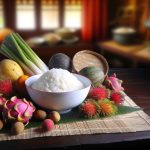Overview:
Turmeric root powder is a popular ingredient in many dishes around the world, and for good reason. This bright yellow powder is derived from the rhizomes of the turmeric plant, which is native to South Asia. Turmeric has been used for centuries for its medicinal properties and unique flavor, and it is now gaining popularity as a nutrient-rich superfood.
Turmeric root powder is known for its anti-inflammatory, antioxidant, and antimicrobial properties, as well as its ability to treat a range of ailments, some of which are listed below:
1. Arthritis: Turmeric has been used to reduce inflammation and pain in people with arthritis. The active ingredient, curcumin, is believed to inhibit the production of certain inflammatory enzymes, reducing joint inflammation and pain.
2. Heart Health: Turmeric is believed to reduce the risk of cardiovascular disease by improving blood flow, lowering cholesterol, and reducing inflammation.
3. Digestive Health: Turmeric has been used to improve digestion, reduce bloating, and relieve constipation. The active ingredient, curcumin, is thought to stimulate the gallbladder and aid in the digestion of fats.
4. Cancer: Studies have shown that turmeric may help slow the growth of certain cancer cells, as well as reduce the side effects of chemotherapy.
5. Brain Health: Turmeric is thought to help improve cognitive function. One study found that turmeric extract helped improve memory and concentration in people with Alzheimer’s.
In addition to its medicinal properties, turmeric root powder has a unique flavor and can be used to add color and flavor to a variety of dishes. It is often used in Indian and South Asian cuisine, as well as in Middle Eastern and Southeast Asian cuisine. Turmeric is used as a spice in curries, marinades, and stews, and is also used to color and flavor rice, lentils, and other grains.
Turmeric root powder is available in many forms, including capsules, powders, teas, and tinctures. It is important to note that the active ingredient, curcumin, is not easily absorbed by the body. To increase absorption, it is recommended to take turmeric with black pepper or a healthy fat, such as olive oil or coconut oil.
In addition to its medicinal and culinary uses, turmeric root powder can be used as a natural dye for fabric or food. To make a natural dye from turmeric, mix one teaspoon of ground turmeric root powder with one cup of boiling water. Allow the mixture to cool and strain it into a bowl or jar. Then, add your fabric or food to the mixture to dye it.
Turmeric root powder is a versatile and nutrient-rich superfood with a variety of medicinal and culinary uses. It has been used for centuries for its anti-inflammatory, antioxidant, and antimicrobial properties, as well as its ability to treat a range of ailments. In addition to its medicinal properties, turmeric root powder can be used to add flavor and color to a variety of dishes, as well as to make a natural dye.
Turmeric root powder has been used for centuries as a spice, medicinal herb, and dye. It is derived from the root of the Curcuma longa plant, which is native to South Asia and is a member of the ginger family.
The historical use of turmeric root powder dates back thousands of years. In India, it has been used for centuries as a medicinal herb to treat a variety of ailments. It has also been used as a spice and dye in food and cloth.
In ancient India, turmeric was used to treat wounds, skin diseases, and joint pain. Its anti-inflammatory properties were believed to be beneficial in treating arthritis and other musculoskeletal conditions. Additionally, it was used to reduce fever and as an antiseptic.
Turmeric was also used in Ayurvedic medicine, a traditional form of medicine that originated in India more than 3,000 years ago. Ayurvedic practitioners believed that turmeric had the power to balance the body’s energies, improve digestion, detoxify the liver, reduce inflammation, and act as an anti-aging agent.
In traditional Chinese medicine, turmeric was used to treat digestive issues and to improve the function of the spleen and liver.
Today, turmeric is widely used as a spice in curries, soups, and stews. It is also used as a natural food coloring, and is a popular ingredient in many health supplements. Its anti-inflammatory properties make it a popular remedy for conditions such as arthritis, joint pain, and inflammation.
Turmeric root powder is a versatile and potent ingredient that has been used for centuries to promote health and wellness. It is easy to incorporate into your diet, and its many health benefits make it a popular choice for those looking for an all-natural way to improve their well-being.
Side Effects of Turmeric Root Powder:
The most common side effects of turmeric root powder are heartburn, nausea, bloating, and diarrhea. Other less common side effects may include headaches, dizziness, rashes, and itching. If you experience any of these side effects after taking turmeric root powder, it is best to stop taking it and speak to your doctor.
Summary of Turmeric Root Powder:
Turmeric root powder is a powerful natural supplement that has been used for centuries in traditional Chinese and Indian medicine. It is derived from the turmeric plant, which is native to South Asia. Turmeric root powder contains numerous beneficial compounds, including curcumin, which is the major active ingredient in turmeric. Studies have shown that curcumin has anti-inflammatory and antioxidant properties, as well as potential anti-cancer benefits. In addition, turmeric root powder may help reduce pain, improve digestion, and boost the immune system. It is typically taken in capsule or powder form, or as a tea. It can also be used as a spice in cooking.
Frequently Asked Questions:
What is turmeric root powder?
Turmeric root powder is a spice made from grinding the dried root of the turmeric plant (Curcuma longa). It is commonly used in Indian and Middle Eastern cuisine, and is known for its bright yellow color and slightly bitter, earthy flavor.
What are the health benefits of turmeric root powder?
Turmeric root powder has been linked to a number of potential health benefits, including reducing inflammation, improving brain function, and lowering the risk of heart disease. It is also a good source of antioxidants, which can help protect cells from damage.
How do I use turmeric root powder in cooking?
Turmeric root powder can be added to a variety of dishes, including soups, stews, curries, and rice dishes. It can also be used as a rub for meats or roasted vegetables.
Is turmeric root powder safe for everyone to consume?
Turmeric root powder is generally considered safe for most people when consumed in moderate amounts. However, it may interact with certain medications and should be used with caution by those with gallbladder problems or blood-thinning conditions.
What is the difference between turmeric root powder and turmeric extract?
Turmeric root powder is made by grinding the dried root of the turmeric plant, while turmeric extract is a concentrated form of the active ingredient in turmeric, curcumin. Turmeric extract is typically more potent and has a higher concentration of curcumin than turmeric root powder.
Can turmeric root powder be used as a natural dye?
Yes, turmeric root powder can be used as a natural dye due to its bright yellow color. It is commonly used in fabric and food coloring.
Can turmeric root powder be used as a supplement?
Yes, turmeric root powder can be taken as a supplement in the form of capsules, tablets, or as a powder. However, it is important to follow recommended dosages and to consult with a healthcare provider before starting any new supplement regimen.









